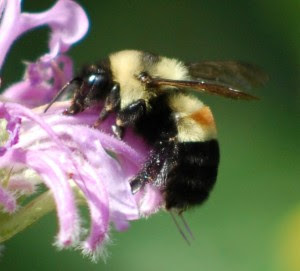SHOCK: For the first time in United States history, several bee species are deemed to be endangered.
By Ernie Mendez, Staff Writer
Bees once lived abundantly throughout the world and have always served as a vital component of farming and agriculture. According to the United States Fish and Wildlife Service, pollinators (mostly bees), have an economic value of around three billion dollars due to their pollination services. Bees also provide jobs for beekeepers, who sell bees to other beekeepers and collect all the products from their hives, like honey.
Considering their importance for the U.S. economy, many were shocked to see that October 2016 marked the first time in United States history that several species of bees were placed on the endangered species list. There are around 20,000 different species of bees, and eight have currently made it onto the endangered species list. The United States Fish and Wildlife Service defines an endangered species as, “animals and plants that are in danger of becoming extinct” on their website. The bees that first made it to the list were seven species of Hawaiian Yellow-Faced Bees and, in early January of 2017, the rusty-patched bumble bee became protected by the Endangered Species Act. This act seeks to protect the bees from harmful activities that pose a threat to them. The Endangered Species Act also serves to raise awareness of the bee population decline, in hopes that people may adopt bee-friendly practices. Since the 1940’s, the honeybee colony population alone dropped from around 5 million to 2.5 million. The decline in population can be attributed to a variety of causes from disease, to pesticide, to habitat loss and climate change.
People seek to conserve the bee population because bees are recognized as one of the most important insects for agricultural growth. They play an integral role in pollination, (a process where pollen from the male part of the flower is transferred to the female part of the flower, which is essentially a plant’s way to reproduce). Some plants rely solely on bees to complete the process of pollination.
Along with bees, all pollinators seem to be threatened around the world. In an article published by NPR “Report: More Pollinator Species in Jeopardy, Threatening World Food Supply,” Merrit Kennedy claims that “about 40 percent of invertebrate pollinator species (such as bees and butterflies) are facing extinction […] About 75 percent of the world’s food crops […] depend at least partly on pollination.” On the U.S. Fish and Wildlife Service website, it is noted that “bumble bees are among the most important pollinators of crops such as blueberries, cranberries and clover and almost the only insect pollinators of tomatoes.”
The U.S. Fish and Wildlife Service is currently working with partners to help save bees and pollinators. Putting these bees on the endangered list is one way to spread awareness and eventually bring the bee population back to what it once was.

